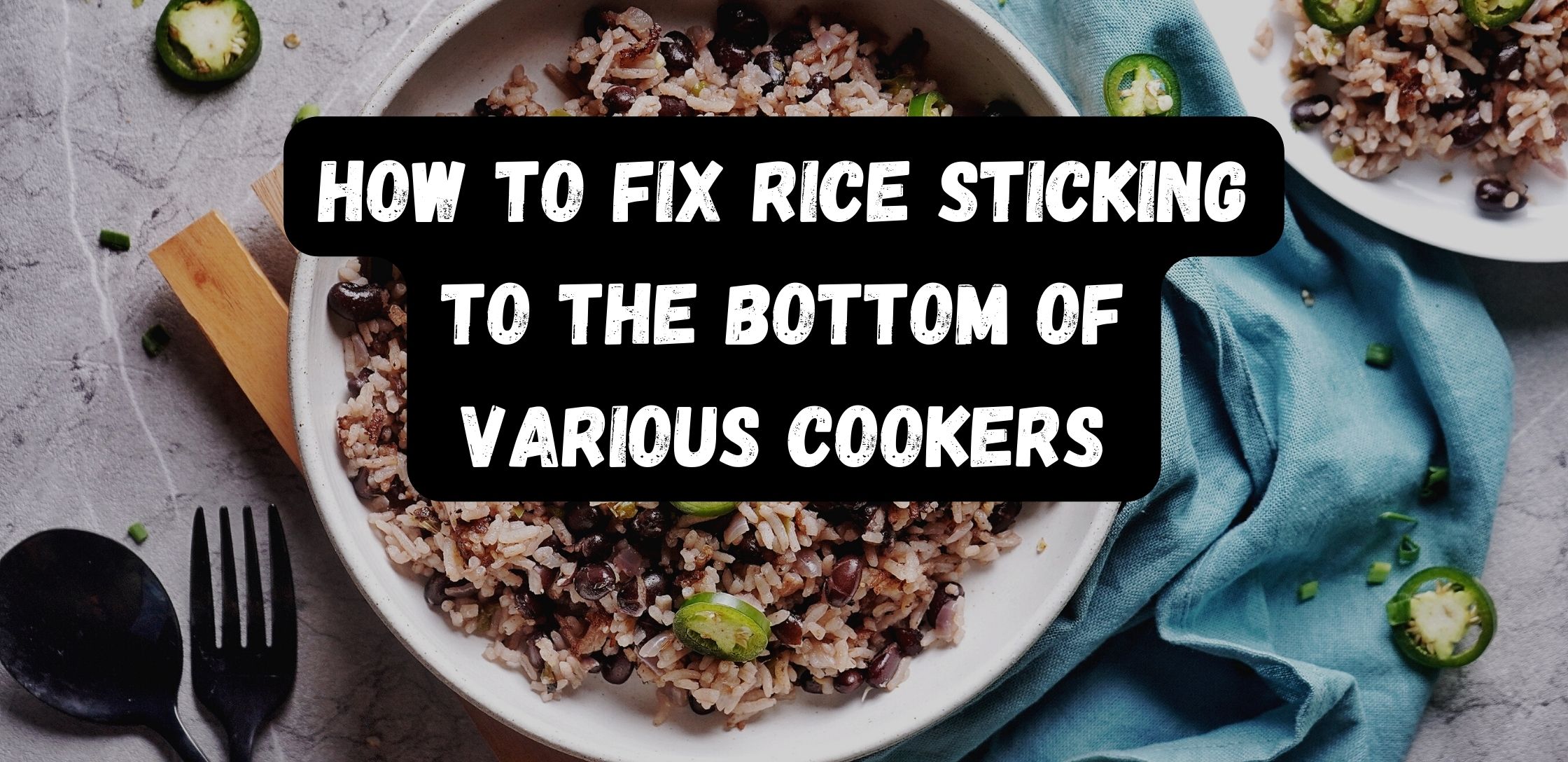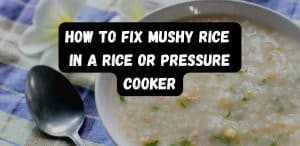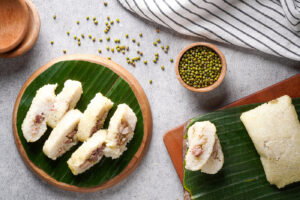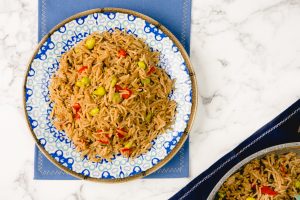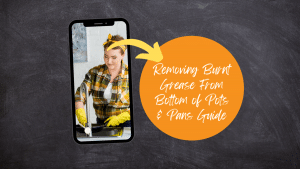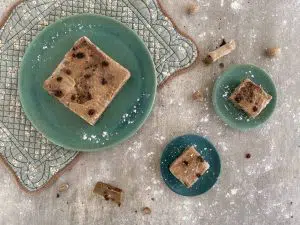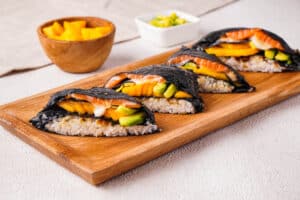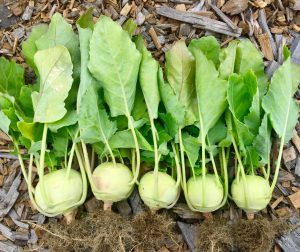How To Fix Rice Sticking To The Bottom Of Various Cookers
Important Note: When you buy through our links, we may earn a commission. As an Amazon Associate we earn from qualifying purchases. Content, pricing, offers and availability are subject to change at any time - more info.
Are you disappointed by your rice? Tired of batting bunches of sticky rice, strangely textured rice instead of enjoying perfectly cooked individual grains? No matter which appliance you’re using to cook rice, we’ve got all the advice needed to know to prevent rice from sticking once and for all. We’re showing you how to fix rice sticking to the bottom of a rice cooker, instant pot, air fryer, a wok, and regular pots or pans.
Key Takeaways
- The main culprits behind rice getting stuck are cooking it at the wrong temperature, with the wrong amount of water for the wrong period of time. Get the ratio of rice to water right, and half the battle is won. Then, it’s just determining the optimal heat and cooking time, and this depends on how you’re cooking the rice in the first place.
- Always wash rice unless you’re making sticky rice or risotto, and always ensure that your rice both cooks and steams before you open the lid to fluff it up and serve. The clearer you can get the water to run, the better, but don’t wash it less than three times if you want to be sure that it won’t stick.
- If your choice of cooker keeps on producing stuck rice no matter how meticulous you are over the rice-to-water ratio, temperature, and cooking duration, then either oil the vessel that the rice is cooking in or add a half a teaspoon of cooking oil per cup of rice to the cooking water.
- At the moment rice is finished cooking and steaming, loosen/fluff the grains apart from each other using a fork or spoon, then dish up immediately. Don’t allow the rice to continue standing in a rice cooker or instant pot with the warming feature on. Feel free to return the bowl to the cooker once the rice has cooled down and then pour over a little water before reheating, but don’t let the unit’s ‘keep warm’ mode prolong the cooking of hot rice, or it’ll end up getting stuck.
Why Rice Gets Stuck To The Bottom Of Various Cookers
Rice gets stuck to the bottom of whatever it is cooking in when it is either overcooked or oversaturated with moisture or the cook employs the wrong technique. All rice, particularly varieties that are high in starch, are prone to getting stuck quickly if the ratio of water to rice isn’t right and the rice isn’t washed.
Most types of rice require just a bout of cooking followed by a short period of steaming whilst off the heat, with the lid kept on. With this being said, knowing your proportions, rice timing, and rice types are vital to having it come out perfectly fluffy.
How To Stop Rice From Sticking To Rice Cooker
| Rice Type | Rice To Water Ratio | Cooking Time | Steaming Time |
| White Rice | 1:1 | 20 – 25 Min | 5 Minutes |
| Brown Rice | 1:2.25 | 50 – 60 Minutes | 10 Minutes |
| Wild Rice | 1:2.25 | 50 – 60 Minutes | 10 Minutes |
| White Basmati Rice | 1:1.75 | 7 – 10 Minutes | 5 Minutes |
| Brown Basmati Rice | 1:2 | 10 – 12 Minutes | 5 Minutes |
| Jasmine Rice | 1:1 | 7 – 10 Minutes | 10 Minutes |
| Arborio Rice | 1:1 | 15 – 20 Minutes | 10 Minutes |
Refrain from using the cook and keep warm feature of your rice cooker as this is what spoils the bottom-most texture of rice for most people. When rice is done cooking, it must steam off the heat, not with low warmth. Simply follow these instructions, and you’ll have perfect rice without any sticking. If your machine has smart sensing and controls the timing automatically, use this feature and follow our measures for water and steaming time. Otherwise, set the timer manually.
- Rinse your rice preferably until the water runs clear but at least three times. Do not rinse your rice if you’re using arborio or any similar grain suited to risotto, or it will never reach the creaminess desired.
- Spray your rice cooker with a non-stick spray or give it a light coating of olive or vegetable oil.
- Follow the chart above to determine the water and cooking time while always cooking rice using the quick cycle instead of a regular cycle if it is available. The only exception is arborio rice which should be cooked using the porridge setting if supported by your rice cooker.
- At the instant that the rice’s cooking time elapses, switch off the cooker and fluff the rice using a fork. Ensure that you carefully work all the rice, starting at the top and gradually loosening and turning the grains at the bottom.
Rice will get stuck to the bottom of a rice cooker if you’re cooking it with the incorrect quantity of water or for too long. At times, certain types of rice will get stuck because of excess starch. We recommend rinsing all rice that you don’t want to have stickiness. It is the sticky starchiness that begins to toast and stick to the bottom of a rice cooker. Improper handling post cooking also results in rice getting stuck.
How To Keep Rice From Sticking To Instant Pot
| Rice Type | Rice To Water Ratio | Cooking Time | Steaming Release |
| White Rice | 1:1.25 | High – 4 – 8 Minutes | Natural Release |
| Brown Rice | 1:1.5 | High – 20 – 22 Minutes | Natural Release |
| Wild Rice | 1:1.5 | High – 20 – 11 Minutes | Natural Release |
| White Basmati Rice | 1:1.25 | High – 3 – 4 Minutes | Natural Release |
| Brown Basmati Rice | 1:1.25 | High – 5 – 6 Minutes | Natural Release |
| Jasmine Rice | 1:1.25 | High – 3 – 4 Minutes | Natural Release |
| Arborio Rice | 1:1.5 | High – 5 – 6 Minutes | Natural Release |
The main reason that rice sticks to the bottom of instant pots and electric pressure cookers is not waiting for the pressure to release naturally. Follow the upcoming instructions while refraining from manually releasing the steam, and as soon as that pin drops in about ten minutes, your rice will be cooked to perfection.
- Rinse your rice until the water runs clear for the best results but at least three times. Do not rinse your rice if you’re making sticky rice or risotto.
- Place the rice and the appropriate quantity of water into the instant pot accompanied by half to one teaspoon of salt per cup, depending on your preference.
- Pressure cook for the relevant period of time and then allow the natural release mechanism to slowly depressurize the instant pot.
- Fluff with a fork and then serve immediately or dispense into a cool dish to serve later.
One shouldn’t need oil to cook rice in a pressure cooker without it sticking as long as you don’t cook it for too long or release the pressure early. However, owners of certain pressure cookers that are prone to get stuck due to general wear and tear on the pot do have a solution. Simply mix in a half a teaspoon of vegetable or olive oil per cup of rice into the water and pressure cook as per usual.
How To Stop Rice From Sticking To Air Fryer
| Rice Type | Rice To Water Ratio | Cooking Time | Steaming Time |
| White Rice | 1:1.5 | 20 – 25 Minutes | 10 Minutes |
| Brown Rice | 1:2 | 35 – 40 Minutes | 15 Minutes |
| Wild Rice | 1:2 | 35 – 40 Minutes | 15 Minutes |
| White Basmati Rice | 1:5 | 10 – 15 Minutes | 10 Minutes |
| Brown Basmati Rice | 1:75 | 14 – 16 Minutes | 10 Minutes |
| Jasmine Rice | 1:5 | 10 – 15 Minutes | 10 Minutes |
| Arborio Rice | 1:3 | 15 – 20 Minutes | 10 Minutes |
- Preheat your air fryer to 400°F with a cake pan that’s either coated with oil or cooking spray placed inside.
- Rinse your rice and shake off the excess while allowing it to drip dry unless making sticky rice or risotto.
- Add the rice, cool water (tap or filter, unrefrigerated) and half a teaspoon of salt per cup of rice used to the baking dish.
- Seal the cake pan neatly with foil.
- Reduce the heat to 360°F and close the air fryer.
- Allow the rice to cook and steam for its correct duration before fluffing then immediately dishing up or dispensing to a new container to serve out of.
Don’t allow the rice to stand in the cake pan while you prepare the rest of supper. This can cause the bottom layer to grow mushy instead of light and fluffy like the rest of the rice. Dispensing into a new vesicle may seem trivial, but you want to get rice away from its heat source as soon as it’s done cooking. Another option to prevent sticking is a non-stick inner pot but with the right technique and possibly the oil trick, it shouldn’t be essential.
How To Make Rice Not Stick To Pot Or Pan
| Rice Type | Rice To Water Ratio | Cooking Time | Steaming Time |
| White Rice | 1:2 | 12 – 15 Minutes | 10 Minutes |
| Brown Rice | 1:2.75 | 30 – 35 Minutes | 10 Minutes |
| Wild Rice | 1:2.75 | 30 – 35 Minutes | 10 Minutes |
| White Basmati Rice | 1:1.5 | 8 – 12 Minutes | 8 Minutes |
| Brown Basmati Rice | 1:1.5 – 1.75 | 10 – 12 Minutes | 8 Minutes |
| Jasmine Rice | 1:1.5 | 8 – 10 Minutes | 8 Minutes |
| Arborio Rice | 1:2.25 | 15 – 20 Minutes | 5 Minutes |
Most of the time, rice gets stuck in a pot when it has been cooked at too high of a temperature. The incorrect level of water will also ruin your rice leading to a crispy, unwanted layer stuck to the pot or mushiness. The wrong pot for rice seldomly causes it to stick, but it can be a factor. Here’s exactly how to make rice, not stick to pots and have it come out perfect every time. Resort to the ratios and timing above as usual.
PLEASE NOTE: Basmati, jasmine, and other aromatic varieties of rice come out best when you add them to the water a few minutes before it reaches a rolling boil and then start timing. Be on the lookout for clusters of bubbles in the water and when these are present, add the rice. Once can make aromatic rice from cold, but it comes out better when started this way.
- Rinse your rice until the water runs clear or at least three times, drain and allow to drip dry in a colander.
- Fill a pot with the correct quantity of water relevant to the portion of rice being prepared. Add half to a full teaspoon of salt per cup of rice.
- Bring the rice to a boil (uncovered), then reduce the heat to low.
- Once simmering, lid the pot and simmer the rice without stirring for the correct duration stated in the table above.
- For the last minute of cooking, put a lid on your pot and allow it to build up steam.
- Remove from the heat and allow the pot of rice to stand, steaming, with the lid on for the appropriate steaming duration.
- Fluff with a fork and serve, or dispense in a suitable container for serving.
A thick, flat-bottom pot without hotspots and a sheer flat surface is the ideal medium for cooking rice. If you have the option, a ceramic thick-bottom pot is the very best pot for cooking rice available.
How To Stop Rice From Sticking To Wok
While one could technically boil up a batch of rice in a wok, woks are made for stir-frying. This implies that if your rice is getting stuck, it’s probably while making fried rice, and in this case, there are a number of possible causes.
- Ensure that your wok is properly seasoned.
- Ensure that your rice is cold.
- Ensure that your rice is dry.
- Ensure that your wok is red hot before adding oil and frying
- Pre-cooked leftover cold rice is best for fried rice.
- Always use oil with a high smoking point, like groundnut oil, peanut oil, canola, or sunflower oil.
How To Prevent Rice From Sticking Tips
Follow the timing, water, and cooking guidance given above combined with these tips, and you can say goodbye to stuck rice forever.
Purchase High-Quality Rice
The quality of the rice makes a big difference in how it comes out. Cheaper varieties of rice are washed cheaply and hastily, which means more starch, unwanted debris, and a degree of sliminess in many cases. Sure, cheap rice can be washed, but the lower the quality, the starchier the rice will be, which means less flavor and a poorer texture when cooked. Quality rice properly cooked will not stick.
Consider Soaking Your Rice
Soaking rice removes any leftover starch that’s stuck to the surface of washed rice, which improves the outcome, and consistency and drastically lowers the chances of it sticking. Starch attached to grains of rice turn gelatinous when cooked in hot water, which gives stuck rice and certain varieties like glutinous rice and arborio its viscous, tacky texture.
Try Using The Rice Knuckle Method
As we’ve mentioned, the correct rice-to-water ratio is imperative to producing fluffy rice cooked to perfection. Seasoned cooks often resort to using the rice knuckle method to gauge how much water rice needs instead of measuring fixed, exact quantities. Here’s a step-by-step for the rice knuckle trick.
- Add the rinsed and drained rice you want to cook to the pot or cooker.
- Level it off so that the rice level is even.
- Place the fingertip of your index finger atop, touching the rice with your finger outstretched/extended above the pot.
- Pour in water until the water level reaches your first knuckle.
Don’t Use The ‘Keep Warm’ Feature
As soon as rice is done cooking, it must be removed from the heat. Don’t resort to using the keep warm feature of your rice cooker or instant pot, and don’t let rice stand for an extended duration in a hot pot even when taken off the stove. After letting it steam, fluff and serve or dispense for serving later. Residual heat will often make well-cooked rice get stuck to the bottom of various cookers if you’re not careful.
Why Rice Getting Stuck Isn’t Always A Bad Thing
The layer of crunchy rice that forms at the bottom of a cooker (conventionally a pot or pan in traditional cooking culture) is a delicacy known by many different names depending where in the world you’re from. For example, like all classic paellas, our delicious, easy to make chicken & chorizo paella and low FODMAP paella should both always feature a socarrat if you’re looking for authentic Spanish flavor. This is, of course, purposefully formed – toasting/burning rice by accident doesn’t count. But, this also means that a slight layer isn’t necessarily a bad thing. Here are just a few of the regional terms you’ll find the toasted layer of rice known as:
- Socarrat – Spain
- Pega – Colombia
- Pegao – Puerto Rico
- Bunbun – Jamaica
- Bun Bun – Trinidad and Tobago
- Kokorota – Cape Verde (Creole)
- Guōbā – China
- Okoge – Japan
- Htamin Gyo – Burma
- Nurungji – Korea
- Kanzo – Ghana
- Intip – Indonesia
- Tahdig – Iran
- Cơm Cháy – Vietnam
How To Stop Rice From Sticking – Frequently Asked Questions
Are you still wondering how to stop rice from sticking? These frequently asked questions about rice getting stuck have all your answers.
Always rinse rice to prevent the excess starchiness from causing it to stick. Rice should be rinsed until clear for the best results. Use the correct ratio of rice to water while cooking rice at a simmer, not a rolling boil. Place a lid on the pot and let it build up steam, or allow the vessel containing your rice to steam for a short period after cooking before opening up, fluffing, and serving. If not serving immediately, transfer to a serving dish to prevent residual heat from making mushy, stuck rice at the bottom.
When cooking rice in a stainless steel pan which is known to be prone to sticking, reduce the simmering time with the lid on by a few minutes and increase the period that you allow the rice to steam off the heat. Instead of fifteen minutes for regular long-grain white rice, give it ten to twelve minutes using stainless steel but let it steam for fifteen minutes with the lid on instead of ten. Using this example, adjust the timing relative to the quantity of rice being cooked.
Yes. Rinsing rice removes residual debris left on the rice, and it strips excess starch, which causes mushy rice with grains that stick together instead of cooking to a good texture separately. For the best end product, wash rice until the water runs clear. Most cooks accept three washes to be the bare minimum. The only time that you won’t rinse rice is when you’re cooking arborio or another rice for risotto or glutinous rice for a sticky rice dish.
Rice prepared early as an advanced meal planning step only becomes hard because it dehydrates as it freezes and thereby loses moisture. Meal prep rice without it getting hard by cooking the rice for a few minutes shorter (two to three for long-grain white rice) than its full recommended duration and place it in the freezer while it is still warm, stored in an airtight container. The airtight vessel stops the moisture from escaping. When you want to reheat your rice, sprinkle over some water and then either microwave-covered or steam-covered on a stovetop.
Start off trying to clean stuck rice by scraping off as much of the crust as possible and then pour in enough white vinegar to cover the bottom. A half, half mix of vinegar and water will also work. Let it stand for twenty to thirty minutes, and then scrub clean. Alternatively, apply an all-purpose cleaner and allow it to eat away at the stuck rice for half an hour before scrubbing. We suggest getting the worst of it off using a wire sponge before switching to regular dishwashing detergent and a normal scourer/scrubber.
